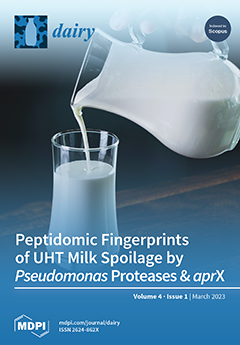The objective of this retrospective case study was to understand the effects of eliminating free-stall lock-up time during 21 days postpartum on milk yield, reproductive performance, and health events at a large dairy herd. A group of 200 cows were selected as the
[...] Read more.
The objective of this retrospective case study was to understand the effects of eliminating free-stall lock-up time during 21 days postpartum on milk yield, reproductive performance, and health events at a large dairy herd. A group of 200 cows were selected as the treatment (TRT) group, which did not receive a lock-up time during early lactation, and a separate group of 200 cows served as the control (CON) group, which received on average 2 h/day of lockup time. The TRT group had greater milk yield (mean ± SE) on the third monthly milk test day (33.1 ± 0.75 vs. 29.9 ± 1.22;
p = 0.04) and tended to have greater milk yield on the second test day (38.3 ± 1.55 vs. 39.1 ± 0.79;
p = 0.06) compared to the CON cows. Milk fat% (mean ± SE) was greater in the TRT group than in the CON group on the first monthly milk test (3.65 ± 0.06 vs. 3.31 ± 0.12,
p = 0.01). The TRT group had lower linear somatic cell scores on the first monthly milk test day compared to the CON group (2.6 ± 0.24 vs. 3.2 ± 0.11;
p = 0.01). Cows in the TRT group had lower days in milk at first breeding (DIMFB) (66.2 ± 3.7 vs. 76.7 ± 2.9;
p = 0.02) and were confirmed pregnant earlier as indicated by smaller days in milk to pregnancy (DIMPREG) (96.9 ± 12.32 vs. 112.1 ± 5.5;
p < 0.01). Cows in the TRT group also had fewer incidences of all health events combined (13% vs. 30.5%;
p < 0.001), lameness (3% vs. 9.5%;
p = 0.01), and mastitis (3% vs. 16%;
p < 0.001). We conclude that eliminating the stall lockup may have contributed to the increased milk yield, health, and reproductive performance of dairy cows in this dairy herd. Future prospective cohort studies are needed to further assess the potential effect of eliminating lock up time on cow performance.
Full article





